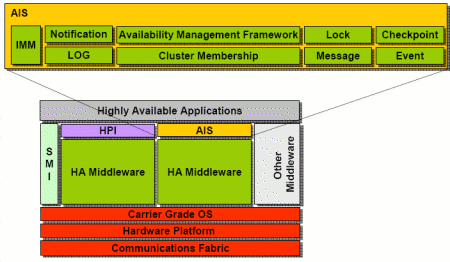High-availability middleware zeroes in on SAForum specs
Aug 21, 2007 — by LinuxDevices Staff — from the LinuxDevices Archive — 4 viewsTelecom software vendor Enea has started shipping a new version of its “carrier-grade” high-availability middleware suite. The company says its Element version 2.2 features an application management framework (AMF) better-aligned with the Service Availability Forum's (SAForum's) Application Interface Specification (AIS) definition.
Element comprises various “middleware” components that sit between a Linux operating system and the carrier's applications, which are called “service” applications. The components provide event logging, application monitoring, shelf management, fault management, and other services aimed at helping carriers achieve 99.999 percent uptime, or about 5 minutes of downtime or less per year.
Since carrier systems are typically distributed across multiple cores, processors, shelves, and chassis, Element uses Enea's Linx IPC (interprocess communications) stack as the underlying foundation. Touting Linx as more scalable than competing HA IPC stacks such as TIPC, Enea released Linx under an open source license earlier this month.
Enea said Element version 2.2's AMF is better aligned with the SAForum's AIS specification (PDF download). AIS defines a standard interface between service applications and high-availability middleware, such as Element. As a key component of AIS, the AMF manages hardware and software redundancy and failover.

SAForum's AIS diagram
(Click to enlarge)
Other touted new features of Element 2.2 include:
- Software management of application executables, image verification and synchronization, cluster boot, image distribution, and support for node-level upgrades
- High-availability support for SAF AMF service units & service groups, and
“N+M” redundancy model - Expanded environment support for heterogeneous, mixed-endian processing environments
Virginia Walker, senior VP of corporate marketing, stated, “Element 2.2 [helps] customers meet expectations for availability and dependability while running on off-the-shelf computing platforms. Our goal is to [help] customers achieve this without having to tailor their applications for each particular hardware platform.”
Enea last revised Element about a year ago, with the release of Element 2.0.
Availability
Enea Element 2.2 is available now. It supports Red Hat Enterprise Linux 4.0, Fedora Core 4.0, and MontaVista Linux 3.1/4, running on Intel and PowerPC processors. Pricing was not disclosed.
This article was originally published on LinuxDevices.com and has been donated to the open source community by QuinStreet Inc. Please visit LinuxToday.com for up-to-date news and articles about Linux and open source.